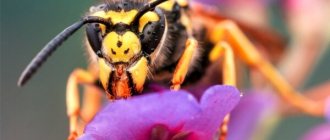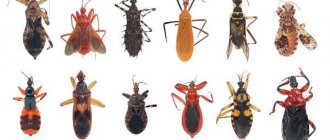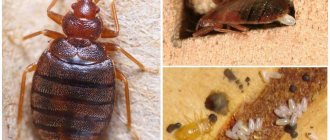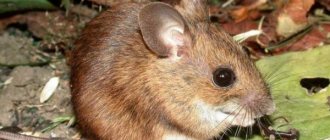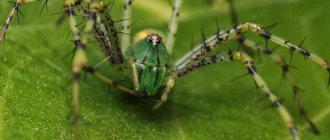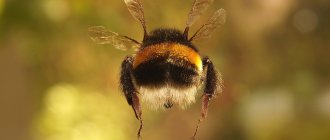The fly is a two-winged nuisance insect from a species of arthropod.
It received this name back from ancient Slavic times from the word “mus”, which translates as “gray”.
What does a fly look like?
Everyone probably knows what this insect looks like, but it’s still worth looking at the presented photos of various flies.
The length of its body ranges from a millimeter level to two cm. The hairy body of the fly has two wings with membranes, a fairly voluminous head and a belly with three pairs of legs.
The mouth is designed like a proboscis that sucks in liquid food. The fly's legs have fairly developed sharp segments and sticky pads that allow it to stay upside down on any surface.
The insect's eyes are designed in a particularly unique way; they contain thousands of hexagonal crystals, which allows the fly to simultaneously see what is happening from absolutely any direction (even the background), that is, it has a circular field of vision. Whiskers are capable of detecting and recognizing many different scents.
Classification of flies by nutrition
Lifestyle shapes nutritional habits. There are several types:
- Afagi. Adults do not feed and live no more than 14 days. The larvae develop and parasitize on humans and animals. A striking representative of aphages are gadflies.
- Nectarophages. Adults feed on plant juices, droppings, and excrement. The larvae develop in a liquid medium, which serves as food for them. Obligate parasites of animals, rarely found on humans. Wohlfart's fly.
- Coprophagous. Adults and larvae feed on excrement. Additional food is plant juices. This species includes pasture flies of the Muscidae family.
- Coprophagous facultative. Maggots develop in excrement, manure, rotten plants, and slops. Adults eat human food. The representative of the species is the house fly.
- Hematophages are obligate. Mature insects feed on blood. The larvae develop in manure, feces, decaying remains of plants, corpses, and feed on the same. This includes the Autumn Zhigalka, which, with the onset of cold weather, makes its way into the house, displacing its indoor relatives.
- Hematophagous facultative. For sexually mature individuals, food consists of secretions from mucous membranes, sweat, and blood protruding from wounds. They cannot bite themselves; their mouthparts are not suitable for this. Additional food is excrement. Maggots also develop there. This species includes the Market fly.
- Necrophages are facultative. Adults feed on decomposing corpse tissue, meat, food waste, juices, and excrement. In most cases, larvae develop in meat. Capable of parasitizing wounds of animals and humans. A striking representative of this species are blowflies - green, blue, gray.
- Polyphages. The diet is very diverse - excrement, body secretions, blood, food waste of animal and plant origin. The larvae adapt to any environment where there is the possibility of feeding. Houseflies are called polyphages.
On a note!
The house fly is a nuisance in residential areas from the beginning of May to the end of July. These are the flies that don't bite. In August they are replaced by zhigalki. They are distinguished by their aggressive disposition, wings protruding to the side, extreme activity, and painful bites. The pest disappears with the onset of persistent cold weather.
Habitats and food of flies
The fly insect is a very heat-loving arthropod and does not tolerate drops in temperature at all. Its habitat is almost the entire globe, excluding cold Antarctica.
They give preference to residential areas, closer to people and animals. The fly can be observed in homes during the warm season, where it invades from early spring to late autumn.
The life of an insect is quite short - a maximum of 2.5 months.
Flies eat almost any organic food that is pre-soaked with their saliva. Sweets occupy the first place in its diet, but there are also exceptional individuals who choose raw vegetables.
Types of flies
The systemic classification of flies has changed as they have been studied, and the final version that would suit all scientists has not yet been developed. There are many factors according to which it is proposed to divide these insects into families, orders and suborders, but the classification of flies into varieties depending on food preferences is considered quite clear and constant.
According to the nature of their feeding, flies are divided into the following types:
- coprophagous (feeds on excrement);
- necrophages (eat dead flesh);
- nectarophages (they are only interested in flower nectar);
- hematophagous (drink blood);
- aphagi (do not eat at all);
- polyphages (their food supply is very diverse).
The division is made according to the feeding habits of adults, since in some species adults and larvae eat different foods. For example, the larvae of the aphage gadfly feed on the blood of people or animals, while adults do not eat at all. Polyphages are the most dangerous, since a fly that has just been in manure may become interested in the products lying on the table, which means leaving a lot of bacteria on them.
Coprophagous
Coprophages are flies that most often live in meadows and pastures, eating animal excrement. In addition, representatives of this species often settle on farms, as well as in private farms - in cowsheds, pigsties and other buildings where domestic animals are kept. This species is more likely to be useful, since coprophages contribute to the breakdown of excrement in the natural environment.
Polyphages
The most famous representative of this species is the common housefly.
Appearance of a housefly
If you do not take into account insects that accidentally fly in from the street, then most often you can find a housefly in an apartment. This is a small insect, reaching 7 mm, and females most often exceed males in size. The body is gray with black longitudinal stripes on the chest and a yellowish belly. Large eyes occupy most of the head. The legs are long and thin, equipped with special suction cups that allow them to move in any direction on any surface.
Nutrition
Since the housefly is a polyphage, its food supply is very extensive. A significant part of the diet consists of liquid food, since the oral apparatus of an adult is not intended for biting. The fly eats solid food, first dissolving it in saliva, which contains a special secretion. The housefly can eat both rotting waste and excrement and human food. For reproduction, the female needs protein food, so flies can often be seen on meat or fish.
Reproduction and development
After the male and female mate, the fly lays eggs. There are from 80 to 120 eggs in one clutch, and in total the female makes from 6 to 20 clutches during her life. The eggs are milky white, elongated, their size is slightly more than 1 mm. Depending on the conditions, the larva emerges from the egg 8 to 48 hours after laying. The fly larva is called a maggot and looks like a small white worm without limbs.
Housefly
The larva develops from 3 to 25 days, undergoing 3 molts during this time. After this, it becomes a pupa and after 3 days a young fly is born. An adult fly lives from 15 to 30 days; under favorable conditions, the period can increase to 2 months.
Necrophages
Necrophages are flies that feed on decaying flesh and feces. They can most often be found near garbage pits and landfills. It is not difficult to distinguish this type of fly from others - they have red eyes. Necrophages include:
- green carrion fly;
- blue blowfly;
- gray blowfly.
Necrophagous larvae are smooth or covered with hairs. The former eat only carrion, while the latter are predators and often attack smooth ones.
Lucilia
Lucilia or green carrion fly is a very beautiful emerald green fly. This is the most numerous type of necrophages. Females lay eggs in feces, rotten flesh, and bleeding or festering wounds. The larvae begin to actively feed immediately after hatching. One of the most common habitats for Lucilia is slaughterhouses.
Blue meat
The blue carrion fly is a fairly large fly, the body size of which can reach up to 1.5 cm. The body of the insect is dark blue, the legs are black. Females lay eggs on open wounds or fresh corpses. This species has been well studied and is widely used in forensic medicine, in particular to determine the time of death. Adults are carriers of intestinal infections.
Gray meat
The gray blowfly is often confused with the housefly. Indeed, the insects are very similar in appearance. However, if you look at the gray blowfly up close, you will notice that its body color is lighter and its eyes are brighter. In addition, the gray blowfly is usually larger, reaching 15 – 25 mm in size. This species is viviparous; females give birth to small larvae. Most often, this species reproduces on the corpses of vertebrate animals.
Hematophagous
Hematophages are a group of flies that feed on the blood of animals or people. The most famous representative of the species is the horsefly. To lay eggs, the female needs to drink fresh blood. At this moment, she is so absorbed in food that she does not notice anything around her. This is why horseflies often die from a blow from a person’s hand or an animal’s tail. An interesting fact is that male horseflies are absolutely harmless and feed on nectar. Females, by the way, can also eat honeydew or plant juice.
Nectarivores
This species includes hoverflies, bigheads, bigeyes. The larvae of some feed on decaying organic matter, while others catch small insects. Adults feed on nectar and play an important role in the pollination of both cultivated and wild plants.
Blue meat
Hoverfly or syrphid
Externally, hover flies are very similar to wasps. They have the same elongated yellow body with black stripes. But unlike wasps, syrphids are absolutely harmless to humans. Moreover, they are considered very beneficial insects, as the larvae eat pests such as aphids, as well as spider mites and the eggs of some insects. Adults feed on pollen and nectar, pollinating plants. The fly got its name because, while hovering in flight, it makes a sound reminiscent of the murmur of water.
Ilnitsa bee-eater
This species belongs to the hoverflies. Externally, the fly is very similar to a bee. She has a yellowish-brown body covered with thick brown hairs, large dark eyes, and black legs. Ilnitsa lays eggs near dirty puddles, drains, and muddy ponds. The larvae feed on organic debris deposited on stones and objects in the water. Adult flies eat nectar, at the same time pollinating plants.
Afagi
Aphages are flies that do not eat at the adult stage. The adult survives on the nutrients that the larva accumulates during development. The most famous representative of the species is the gadfly. Despite the popular belief that gadflies, like horse flies, drink blood, adult flies do not bite. Their danger lies elsewhere. They lay eggs on the grass that livestock eats, on the fur or under the skin of animals. The hatched larvae live in the host’s body, feeding on its flesh, and emerge to the surface only at the time of pupation.
Dung fly
Dung beetle - outwardly stands out from other varieties. This is a medium-sized insect (10 - 15 mm), whose entire body is covered with fluffy red or light brown hairs. Males are more brightly colored, their body is golden yellow with orange hairs, females are duller, greenish-brown.
The dung fly is so called because it lays eggs in manure. The larvae that emerge from the eggs live and feed there. But adult flies are predatory insects with well-developed jaws. They hunt other representatives of the order Diptera.
Flies are mischievous
This species includes small insects, 12–15 mm long, with a grayish-brown body. They have a small, round head with large eyes located close together. Tolkuns are predators. They feed mainly on small flies of other species. The insects got their name because before mating, the males gather in large groups and begin to perform a kind of dance in the air, as if they were colliding. This way they attract the attention of females.
Tolkuntsy
Ktyri flies
The fly is a predatory insect that can be found all over the world. The elongated slender body of the fly reaches from 3 to 30 mm (some tropical varieties grow up to 70 mm). The color is brown with black or gray. The larvae develop in rotting organic matter or soil and feed on other larvae or small insects. Adults are very aggressive. They attack insects, and can even attack such dangerous opponents as a wasp or a bee.
Piedwings
Piedflies are a fairly common group of flies that get their name from the mottled pattern on their wings. The sizes of representatives of the family vary from 3-4 mm to 2 cm. Most often they feed on plant foods. Some species, such as the Mediterranean fruit fly, are dangerous pests of fruit crops.
Mayflies
Mayflies are flies with a long, narrow body and thin, mesh-like wings. Adults live from 3-4 hours to several days, all this time without food. Females lay eggs on water. Mayfly larvae live in water and feed on plant debris.
Iris fly
The iris fly is a pest that mainly affects irises. The insect looks like an ordinary fly, but its color is gray with golden spots. Adult flies feed on iris buds and lay eggs in them. The hatched larvae eat the tissues of the flowers.
Gardeners are constantly fighting this insect, but it is quite difficult to cope with. However, if you apply comprehensive control methods, you can save iris plantings even with large-scale infection.
Other
Among flies there are quite a lot of pests of garden and vegetable crops, for example:
- cherry fly;
- raspberry fly;
- melon fly;
- cabbage fly;
- onion fly.
Females lay eggs on the fruits, and the hatched larvae eat them, causing significant damage to the crop. But small black insects - April flies, flying over fruit trees during flowering, are not dangerous and contribute to pollination.
There is also a category of biting flies. One of the most dangerous is the tsetse fly, which can be distinguished by its reddish-brown body and specially folded wings (at rest, one wing completely covers the other).
Onion
There are flies that parasitize animals, such as the deer fly.
Hoverfly or syrphid
Very similar to a wasp. In the summer, you can see such a fly hovering over flowering plants, or near a cluster of garden aphids.
This specimen is safe for humans. It feeds on the nectar of inflorescences and spider mites. The buzzing of a fly resembles the sound of rushing water, which is why it got its beautiful name.
Who is a housefly?
When considering this term, it is worth mentioning two points of view. To begin with, this is an ordinary person who encounters winged insects and does not go into detail. Also, it is worth mentioning the position of a more enthusiastic person.
So, from a biologist's perspective, houseflies are a separate species that have a specific characteristic. During the summer, they live in close proximity to people.
It has a dark gray coloring and is large, but not the largest in size. Due to the soft proboscis, a bite is impossible, so the housefly has to feed on liquid food. Often attracted by food or waste products.
From the perspective of a common person, any creature with two wings that is in the house can be attributed to a housefly. It is unlikely that anyone is very keen on the presence of melon, cherry or raspberry flies.
This point of view is not surprising, because there is simply no need to know all types of flies - there are more than 150 of them.
Photo of a fly
Appearance of insects
Fruit flies are small, midge-like flies, typically pale yellow to reddish brown to black in color, with red eyes. Many species, including the Hawaiian fruit fly, have various black patterns on their wings. The so-called pinnate species of Arista have setae on the head and thorax, as well as a specific pattern of venation on the wings, which is used to identify the family. Most flies are small, about 2-4mm long, but some, especially Hawaiian flies, are larger than a housefly.
Wild-type individuals are yellow-brown in color, with brick-red eyes and black transverse rings throughout the abdomen. The flies exhibit sexual dimorphism: females are about 2.5 millimeters long and males are slightly smaller, with darker backs. Males are easily distinguished from females by color differences, with a distinct black spot on the belly and a row of dark setae on the tarsi in the first pair of legs. In addition, males have better developed hind pairs of limbs, which serve them to more effectively hold females during mating.
Link to topic
Learn more about mosquitoes in the article Life Cycle of Mosquitoes.
Reproduction of flies
With the exception of some viviparous species, most flies lay eggs. Males attract females with a low buzzing sound. 2-3 days after mating, the female fly is ready to lay eggs in any food or organic waste.
One clutch contains approximately 150 eggs. During its existence, a female fly can lay up to 3 thousand eggs. After a day, fly larvae and maggots appear.
This stage of development lasts about a week, during which time the larva increases in size up to 800 times.
The larval stage enters pupation and continues for another week. An adult fly, which does not change its size throughout its life, is born 12-14 days after laying eggs.
For the first 2-3 days, until the wings become stronger, the insect can only crawl. The average lifespan of a fly is 3 weeks.
Interesting facts about fruit flies
- Each insect eye contains up to 760 small optical units - ommadia, and each ommadia consists of 8 receptors that react to light in different ways. Reddish eye pigments extinguish too bright light and enhance weak ones, so the fly of this species is perfectly oriented in any weather, and its vision is considered the most developed among all types of insects.
- The Drosophila fly makes up to 220 wing beats during flight. This is the highest indicator among all insects, but it is completely inaudible, which is ensured by the special shape of the wings. It was according to the geometric relationships of the wings of this insect that the propeller blades were made.
- These flies do not cause any harm to humans, except when they are bred in winter storage of fruits and vegetables.
- An interesting fact is how long an insect lives - the lifespan of a sexually mature individual does not exceed only 24 hours.
Drosophila flies are absolutely harmless and are widely used in genetic research due to their special structure of the DNA molecule. Many of the pharmacological drugs we effectively take today were primarily tested on these small red-eyed insects. Scientists really hope that this tiny creature will help to understand the causes of the development and methods of treating cancer; work in this area is being carried out very actively today.
